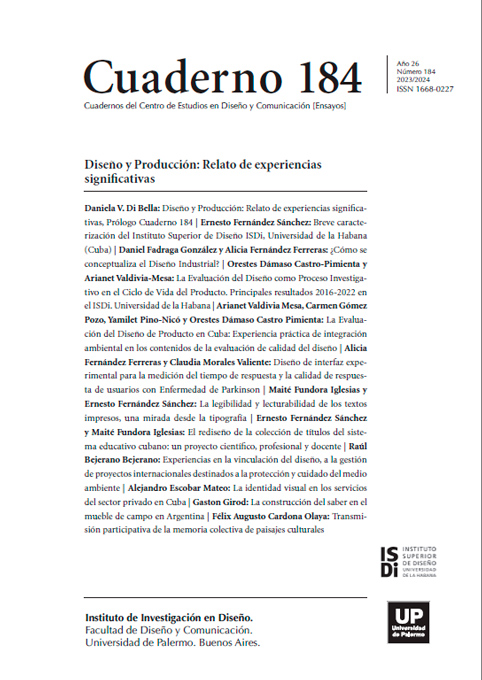Diseño de interfaz experimental para la medición del tiempo de respuesta y la calidad de respuesta de usuarios con Enfermedad de Parkinson
Abstract
This paper presents the results of an interdisciplinary study in the field of Design in relation to disciplines such as Psychology, Neurology and Electro-medicine with the aim of designing an experimental device that independently presents the Design Variables of Home Appliance Control Interfaces that affect the time and quality of response of users with Parkinson’s Disease (PD).
References
Álvarez, M. (20 de marzo de 2014). Enfoque multidisciplinario a enfermedades neurodegenerativas. (M. Jiménez, Entrevistador) Juventud Rebelde. Obtenido de http://www.juventudrebelde.cu/cuba/2014-03-20/enfoque-multidisciplinario-a-enfermedades-neurodegenerativas
Arroyo, M., & Finkel, L. (2014). Requisitos para una vida cotidiana asistida en hogares con enfermos de Parkinson. Departamento de Sociología IV. Universidad Complutense de Madrid.
Clarkson, P., & Coleman, R. (2015). History of inclusive design in the UK. Applied Ergonomics, 46(Part B), 235-247.
Coleman, R. (1994). The case for inclusive design - An overview. In Proceedings of the 12th Triennial Congress of the International Ergonomics Association. Toronto: International Ergonomics Association.
Del Tredici, K., & Braak, H. (2012). Lewy Pathology and Neurodegeneration in Premotor Parkinson’s Disease. Mov Disord, 25(7), 597-607.
Del Tredici, K., & Braak, H. L. (2012). Payhology and Neurodegeneration in Premotor Parkinson´s Disease. Movement Desorders, 5(27), 597-607.
EIDD. (2004). Stockholm Declaration. Obtenido de Design for All Europe: http:// www.designforalleurope.org/Design-for-All/EIDD-Documents/Stockholm-Declaration/
Fahn, S., Jankovic, J., Hallett, M., Okun, M., & Comella, C. (2021). Principles and Practice of Movement Disorders (3rd ed.). Elsevier.
Giroud, J. B., Collado-Mesa, F., & Esteban, E. M. (2000). Prevalence of Parkinson disease in an urban area of Ciudad de La Habana province, Cuba. Door-to-door population study. Neurologia, 15(7), 269-273.
Huster, R., Mokom, Z., Enriquez-Geppert, S., & Herrmann, C. (2013). Brain–computer interfaces for EEG neurofeedback: Peculiarities and solutions. International Journal of Psychophysiology.
Imrie, R., & Hall, P. (2001). Inclusive Design: Designing and Developing Accessible Environments. London: Spon Press.
Karwowski, W., & Marras, W. (2006). The Occupational Ergonomics Handbook (2nd ed.). USA: CRC Press.
Mace, R. (1985). Universal design: Barrier free environments for everyone. Designers West, 33(1), 147-152.
Maetzler, W., & Hausdorff , J. (2012). Motor Signs in the Prodromal Phase of Parkinson’s Disease. Mov Disord, 27(5), 627-33.
Mao, J. Y., Vredenburg, K., Smith, P. W., & Carey, T. (2005). The state of user-centered design practice. Communications of the ACM, 48(3), 105-109.
Martínez-Jurado, E., Cervantes-Arriaga, A., & Rguez-Violante, M. (2010). Calidad de vida en pacientes con Enfermedad de Parkinson. Revista Mexicana de Neurociencia, 11(6), 480-486.
Mason, S., & Birch, G. (2003). A General Framework for Brain–Computer Interface Designe. IEEE Transactions on Neural Systems and Rehabilitation Engineering, 11(1).
Ministerio de trabajo y asuntos sociales. (2006). NTP 214: Mandos y señales: ergonomía de percepción. Notas Técnicas de Prevención. España.
Norman, D. A., & Draper, S. W. (1986). User-Centered System Design: New Perspectives on Human-Computer Interaction. . Hillsdale, NJ.: Lawrence Earlbaum Associates.
Organización Mundial de la Salud. (2015). Envejecimiento y salud. Obtenido de Organización Mundial de la Salud: http://www.who.int/es/news-room/fact-sheets/detail/envejecimiento-y-salud
Parada, Y., Soto, A., Lara, G., Santos, A., Hernández, T., & Mesa, Y. (2012). Síntomas no motores en pacientes con enfermedad de Parkinson. Revista Cubana de Tecnología de la Salud, 4(3).
Pérez, M. (2022). Requisitos ergonómicos cognitivos a considerarse en el diseño de interfaces de usuario orientadas a adultos mayores cubanos con autonomía y validismo. La Habana.
Preece, J., Rogers, Y., & Sharp, H. (2002). Interaction design: Beyond human-computer interaction. New York: John Wiley & Sons, Inc.
Preiser, W., & Ostroff, E. (2001). Universal Design Handbook. New York: McGraw-Hill.
Rodea, A. (2011). Diseño para poblaciones especiales, tratamiento antropométrico y estadística. En C. Flores, M. E. Heredia, A. Rodea, E. Morales, B. L. Salazar, L. A. Vázquez, . . . A. Rodríguez, Diseño y Ergonomía para poblaciones especiales (págs. 71-87). México: Designio.
Rodnitzky, R. L. (2013). Visual Disfunctions in Parkinson’s Disease. En C. d. Autores, Parkinson’s Desease and Non Motor Dysfunctions (Segunda ed., págs. 305- 315). Humana Press.
Rojas, C., & García, H. (2013). Diseño inclusivo: La participación activa de las personas. Revista KEPES, 10(9), 297-314.
Sampieri, R., Fdez Collado, C., & Baptista Lucio, M. (2014). Metodología de la Investigación. DF, México: McGraw-Hill.
Steinfeld, E., & Tauke, B. (2002). Universal designing. En Universal Design. 17 Ways of Thinking and Teaching (J. Christophersen ed., págs. 165-189). Norway: Husbanken.
Tamayo y Tamayo, M. (2004). Diccionario de la investigación científica (Segunda ed.). México: Limusa.
Tinazzi, M., Del Vesco, C., Fincati, E., Ottaviani, S., Smania, N., & Moretto, G. (2006). Pain and motor complications in Parkinson´s Disease. Journal of Neurology and Neurosurgery Psychiatry(77), 822-825.
Los autores/as que publiquen en esta revista ceden los derechos de autor y de publicación a "Cuadernos del Centro de Estudios de Diseño y Comunicación", Aceptando el registro de su trabajo bajo una licencia de atribución de Creative Commons, que permite a terceros utilizar lo publicado siempre que de el crédito pertinente a los autores y a esta revista.


